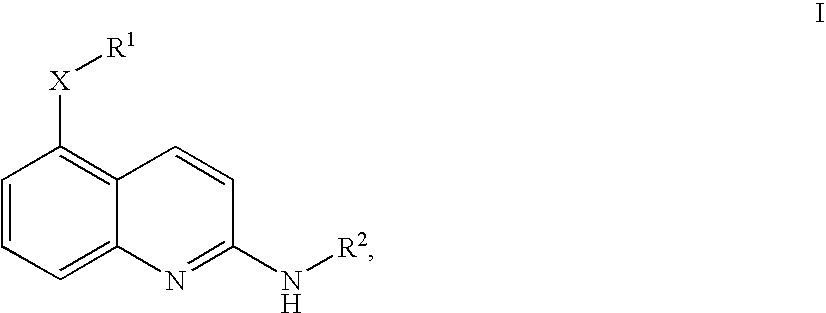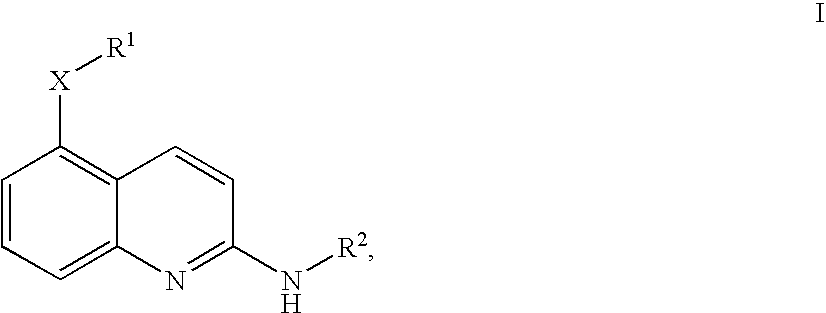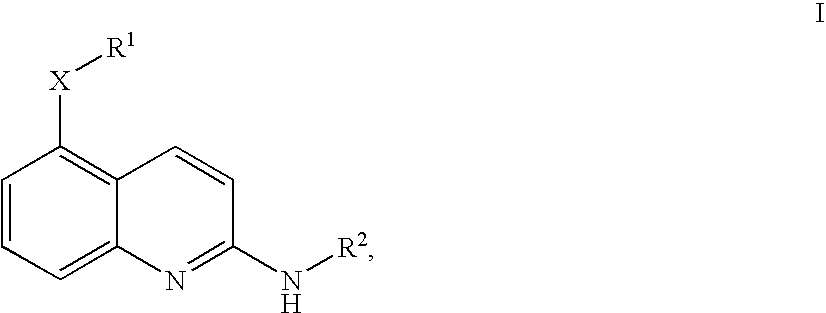Quinolines
a technology of aminoquinoline and quinoline, which is applied in the field of 2aminoquinoline derivatives, can solve the problems of limited pharmacological characterization of the 5-htsub>5a /sub>receptor and lack of behavioral data, and achieve good affinity
- Summary
- Abstract
- Description
- Claims
- Application Information
AI Technical Summary
Benefits of technology
Problems solved by technology
Method used
Image
Examples
example 1
4-Fluoro-N-[2-((R)-indan-1-ylamino)-quinolin-5-yl]-benzenesulfonamide
Step A
[0329]5-Nitro-2-chloroquinoline (CAS 13067-94-2, 5.0 g, 24 mmol) was dissolved in 500 mL ethanol and platinumoxid hydrate (176 mg, 0.718 mmol) was added. The reaction mixture was hydrogenated with a hydrogen ballon at room temperature overnight and filtered. The filtrate was evaporated off. The crude 5-amino-2-chloroquinoline (4.58 g) was used without further purification for the next step.
Step B
[0330]5-Amino-2-chloroquinoline (1.0 g, 5.6 mmol) was dissolved in 10 mL pyridine and 4-fluorobenzenesulphonylchloride (1.1 g, 5.7 mmol) was added. The reaction mixture was stirred at room temperature overnight and quenched by addition of 100 mL water and 6.8 mL acetic acid. The mixture was extracted three times with ethyl acetate (100 mL each). The organic phases ware pooled, dried with sodium sulfate, filtered and evaporated. The residue was purified by flash chromatography on silica gel (cyclohexane / ethyl acetate 1...
example 2
[5-(4-Fluoro-benzyloxy)-quinolin-2-yl]-(R)-indan-1-yl-amine
Step A
[0332]5-Hydroxy-2-chloroquinoline (CAS 124467-35-2, 0.6 g, 3.0 mmol) was dissolved in 15 mL acetone and potassium carbonate (555 mg, 3.0 mmol) was added. Then 4-fluoro-benzylbromide (0.5 ml, 4.0 mmol) was added and the reaction mixture stirred for 18 hours at ambient temperature. The mixture was evaporated and the residue taken up in water and extracted (3×) with ethyl acetate. The combined organic phases were dried over sodium sulfate and evaporated. The residue was subjected to flash column chromatography on silica gel (heptane / ethyl acetate 90:10->80:20 gradient) to yield 2-chloro-5-(4-fluoro-benzyloxy)-quinoline as a white solid (420 mg, 44%), MS: m / e=289 (M+H+).
Step B
[0333]2-Chloro-5-(4-fluoro-benzyloxy)-quinoline (100 mg, 0.347 mmol) and (R)-1-aminoindane (138 mg, 1.04 mmol) were stirred in a sealed tube at 150° C. overnight. The reaction mixture was purified by flash chromatography on silica gel (heptane / ethyl a...
example 3
(R)-Indan-1-yl-[5-(3-methoxy-benzyloxy)-quinolin-2-yl]-amine
[0334]The title compound, MS: m / e=397.5 (M+H+), was prepared in accordance with the general method of example 2 from 5-hydroxy-2-chloroquinoline, 3-methoxy-benzylbromide and (R)-1-aminoindane.
PUM
| Property | Measurement | Unit |
|---|---|---|
| Molar density | aaaaa | aaaaa |
| Molar density | aaaaa | aaaaa |
| Molar density | aaaaa | aaaaa |
Abstract
Description
Claims
Application Information
 Login to View More
Login to View More - R&D
- Intellectual Property
- Life Sciences
- Materials
- Tech Scout
- Unparalleled Data Quality
- Higher Quality Content
- 60% Fewer Hallucinations
Browse by: Latest US Patents, China's latest patents, Technical Efficacy Thesaurus, Application Domain, Technology Topic, Popular Technical Reports.
© 2025 PatSnap. All rights reserved.Legal|Privacy policy|Modern Slavery Act Transparency Statement|Sitemap|About US| Contact US: help@patsnap.com



